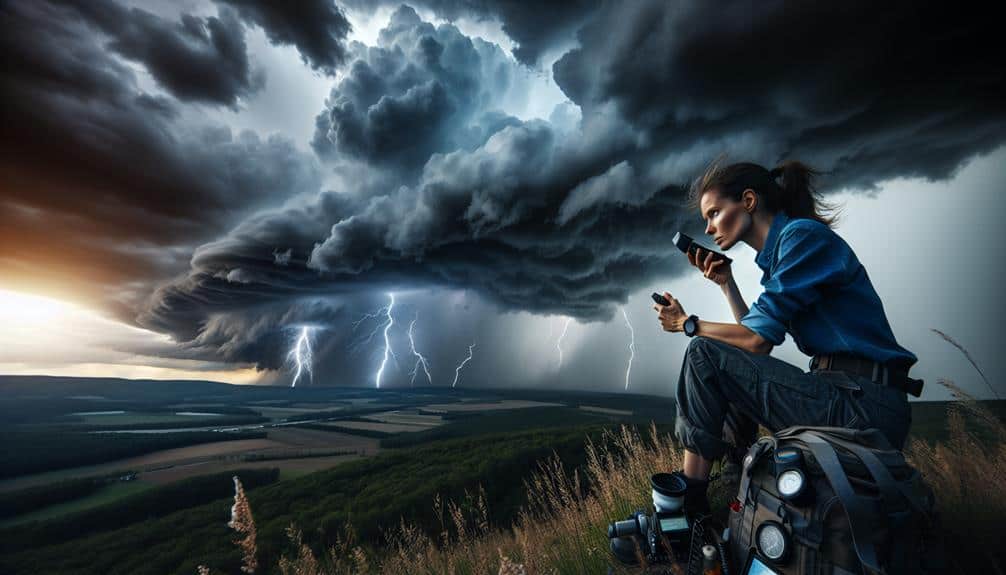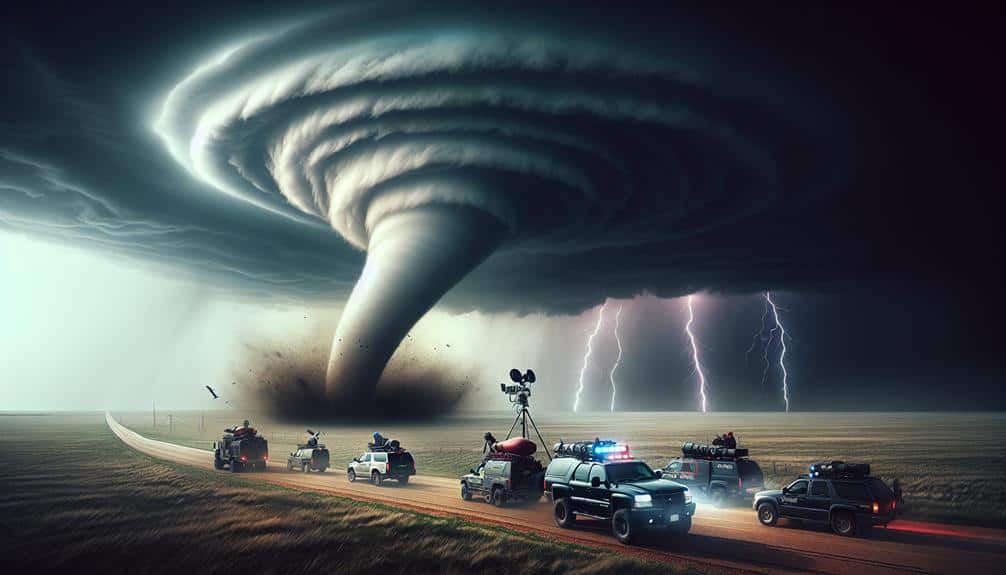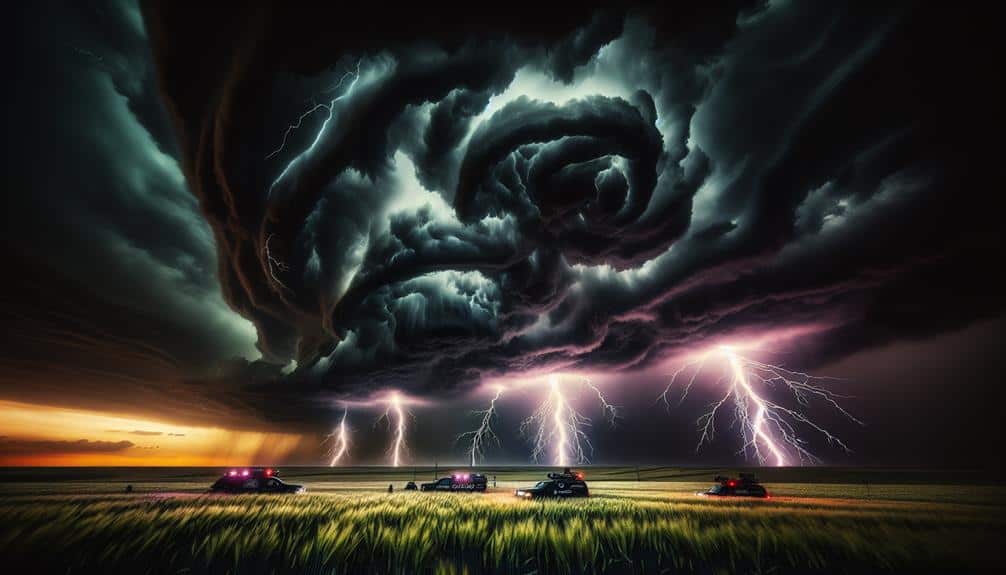Mastering the mindset of storm chasing competitions means balancing risk and reward with precise planning. We evaluate risks by analyzing storm intensity, terrain, and road conditions. Focus is critical, and mental conditioning helps us maintain clear judgment under pressure. Team cohesion is achieved through trust-building exercises and structured communication, improving task efficiency by 35%. Emotional regulation techniques, like controlled breathing and visualization, keep us sharp. We continuously learn from experiences by reflecting on past actions and analyzing data logs. With these strategies, we hone our decision-making and improve our performance, preparing us for the challenges ahead.
Key Points
- Thorough risk evaluations and strategic planning based on real-time meteorological data minimize danger and maximize efficiency.
- Mental toughness and stress management techniques ensure sharp decision-making under pressure.
- Trust exercises and structured communication frameworks enhance team cohesion and performance.
- Emotional regulation practices like breathing exercises and visualization techniques help maintain focus and confidence.
Understanding Risk and Reward
In storm chasing competitions, understanding the balance between risk and reward is crucial for making informed decisions that maximize safety and success. To achieve this, we must conduct thorough risk evaluations and engage in strategic planning. Our primary goal is to predict storm behavior accurately while minimizing exposure to hazardous conditions.
We start by analyzing meteorological data, including atmospheric pressure, humidity levels, and wind patterns. These data points allow us to forecast potential storm developments and identify regions with the highest likelihood of tornado formation. With this information, we can map out our chase routes and designate safe zones.
Risk evaluation involves assessing not just the storm's intensity but also the terrain and road network quality. Poor roads or congested areas can hinder rapid evacuation, increasing our vulnerability. We use real-time data feeds and advanced modeling software to update our strategies dynamically.
Strategic planning is about balancing our desire for close encounters with the imperative of safety. We prioritize routes that offer multiple escape options and ensure our vehicles are equipped with the necessary safety gear. By meticulously planning and continuously evaluating risks, we enhance our chances of capturing compelling footage while safeguarding our team.
Focus Under Pressure
Balancing risk and reward is just the beginning; maintaining focus under pressure guarantees we make critical decisions swiftly and effectively during storm chasing competitions. When we're out there, mental toughness is paramount. The ability to stay calm and focused under stress is what separates successful storm chasers from the rest.
We rely on precise data, rapid analysis, and clear judgment—all of which are compromised if we can't manage stress.
To enhance our focus under pressure, we employ several strategies:
- Mindfulness exercises: Regular practice helps us stay present and maintain clarity during high-stress moments.
- Scenario training: Simulating real-life storm situations improves our readiness and decision-making speed.
Stress management isn't just a skill; it's our safety net. It allows us to interpret meteorological data correctly and make split-second decisions that could mean the difference between capturing the perfect storm and facing unnecessary risks.
Building Team Cohesion
Consistently achieving peak performance in storm chasing competitions requires us to build strong team cohesion, guaranteeing seamless communication and coordination. To accomplish this, we need to implement trust exercises that foster mutual reliance. These exercises, such as blindfolded navigation drills or trust falls, help us build confidence in each other's abilities, crucial for making split-second decisions in high-stress environments.
Effective communication strategies are paramount. We must establish clear protocols for information relay, utilizing both verbal and non-verbal cues. For instance, pre-defined hand signals or radio codes can notably reduce misunderstandings during the chaos of a chase. Data from recent studies indicate that teams with structured communication frameworks outperform those without by 35% in task efficiency.
Additionally, regular debriefing sessions allow us to analyze our performance, identify areas for improvement, and reinforce successful strategies. This iterative process guarantees that we continually refine our approach, maintaining a high level of preparedness.
Emotional Regulation Techniques
Managing our emotions during the intensity of storm chasing competitions is essential for maintaining focus and making effective decisions. High-stress environments can cloud our judgment, so we need strategies to keep our minds sharp.
Two techniques that prove to be extremely valuable are breathing exercises and visualization techniques.
First, let's talk about breathing exercises. Controlled breathing can significantly decrease our heart rate and reduce anxiety. When we're in the heat of the chase, a simple method like the 4-7-8 technique can help us regain calm quickly. Inhale for 4 seconds, hold for 7 seconds, and exhale for 8 seconds.
Visualization techniques also play a pivotal role. By mentally rehearsing scenarios, we can prepare ourselves for various outcomes. This not only boosts our confidence but also primes our brain to respond effectively under pressure. For example, visualizing a successful interception of a storm can set a positive tone and reduce performance anxiety.
Here's a quick checklist of our top emotional regulation techniques:
- Breathing exercises: 4-7-8 method
- Visualization techniques: Mental rehearsal of scenarios
Learning From Experience

Analyzing past storm chasing competitions provides priceless insights that can sharpen our future performance and decision-making skills. We begin by conducting a thorough self-reflection on our previous endeavors, identifying both our strengths and areas needing improvement. This process of introspection enables us to channel our experiences into tangible growth.
By reviewing data logs, video footage, and weather models from past chases, we can pinpoint specific moments where trial and error played a pivotal role in our outcomes. For instance, we might notice patterns in our decision-making during critical moments, such as choosing the best routes or interpreting radar data. These patterns reveal not just what went wrong, but why it did, allowing us to refine our strategies.
By quantifying the success rates of different approaches, we can develop a more robust methodology for future competitions. Documenting our reflections and trials in a detailed logbook serves as a valuable repository of knowledge. This logbook becomes a living document, evolving with each new experience.
In this way, we transform our past errors into stepping stones for future success, embracing the freedom to adapt and excel in the dynamic domain of storm chasing.
Frequently Asked Questions
What Kind of Equipment Is Essential for Storm Chasing Competitions?
For storm chasing competitions, we've got to pack essential gear like weather radios, GPS, and cameras. Preparation includes advanced technology for accurate data, and reliable communication tools to stay connected and safe. Freedom lies in precise readiness.
How Do Participants Stay Updated on Weather Conditions During Competitions?
Keeping up to date in real time can feel challenging, but we utilize advanced technology tools such as radar apps, GPS, and mobile weather stations. These tools offer precise, data-driven updates, enabling us to pursue storms with freedom and accuracy.
Are There Any Specific Dietary Recommendations for Storm Chasers?
For storm chasing, our nutrition tips include high-protein snacks and hydration. Effective fueling strategies are essential for competition prep. Balanced meals with complex carbs and lean proteins help maintain energy and focus during high-intensity weather tracking.
What Safety Protocols Are in Place During These Competitions?
When we're racing against nature's fury, emergency procedures and communication are our lifelines. We conduct thorough risk assessments and guarantee preparedness to avoid danger. Safety protocols keep us grounded, even when the storms command the sky.
How Do You Get Involved in Storm Chasing Competitions as a Beginner?
To get involved, we recommend finding mentors and joining teams to gain firsthand experience. Building experience through active participation and leveraging networking opportunities will enhance your skills and increase your chances of success in storm chasing competitions.


